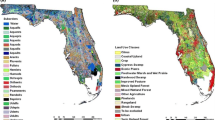Abstract
This paper compares the performance of four algorithms (full indicator cokriging. adjacent cutoffs indicator cokriging, multiple indicator kriging, median indicator kriging) for modeling conditional cumulative distribution functions (ccdf).The latter three algorithms are approximations to the theoretically better full indicator cokriging in the sense that they disregard cross-covariances between some indicator variables or they consider that all covariances are proportional to the same function. Comparative performance is assessed using a reference soil data set that includes 2649 locations at which both topsoil copper and cobalt were measured. For all practical purposes, indicator cokriging does not perform better than the other simpler algorithms which involve less variogram modeling effort and smaller computational cost. Furthermore, the number of order relation deviations is found to be higher for cokriging algorithms, especially when constraints on the kriging weights are applied.
Similar content being viewed by others
References
Carr, J. R., and Deng, E. D., 1987, Comparison of Two Techniques for Applying Disjunctive Kriging: The Gaussian Anamorphosis Model Versus the Direct Statistical Inference of the Bivariate Distributions: Math. Geol., v. 19, p. 57–68.
Chu, J., 1993, XGAM User's Guide: Stanford Center for Reservoir Forecasting: Stanford University, Unpublished Annual Report, no. 6.
Deutsch, C. V. and Joumel, A. G., 1992, GSLIB:Geostatistical Software Library and User's Guide: Oxford University Press, New York, 340 p.
Goovaerts, P., 1994, Comparison of coIK, IK, and mIK Performances for Modeling Conditional Probabilities of Categorical Variables,in R. Dimitrakopoulos, ed.,Geostatistics for The Next Century, p. 18–29.
Goulard, M., and Voltz, M., 1992, Linear Coregionalization Model; Tools for Estimation and Choice of Cross-Variogram Matrix: Math. Geol., v. 24, p. 269–286.
Journel, A. G., 1983, Non-Parametric Estimation of Spatial Distribution: Math. Geol., v. 15, p. 445–468.
Journel, A. G., 1986, Geostatistics: Models and Tools for the Earth Sciences: Math. Geol., v. 18, p. 119–140.
Journel, A. G., and Huijbregts, C. J., 1978,Mining Geostatistics: Academic Press, London, 600 p.
Journel, A. G. and Posa, D., 1990, Characteristic Behavior and Order Relations for Indicator Variograms: Math. Geol., v. 22, p. 1011–1025.
McBratney, A. B., Webster, R., McLaren, R. G., and Spiers, R. B., 1982, Regional Variation of Extractable Copper and Cobalt in the Topsoil of South-East Scotland: Agronomie, v. 2, p. 969–982.
Rivoirard, J., 1993, Relations Between the Indicators Related to a Regionalized Variable,in A. Soares, ed.,Geostatistics Troia '92 (Vol. 1): Quantitative Geology and Geostatistics: Kluwer Academic Publishers, p. 273–284.
Wackernagel, H., 1994, Cokriging vs. Kriging in Regionalized Multivariate Data Analysis: Geoderma, v. 62, 83–92.
Author information
Authors and Affiliations
Rights and permissions
About this article
Cite this article
Goovaerts, P. Comparative performance of indicator algorithms for modeling conditional probability distribution functions. Math Geol 26, 389–411 (1994). https://doi.org/10.1007/BF02089230
Received:
Accepted:
Issue Date:
DOI: https://doi.org/10.1007/BF02089230




